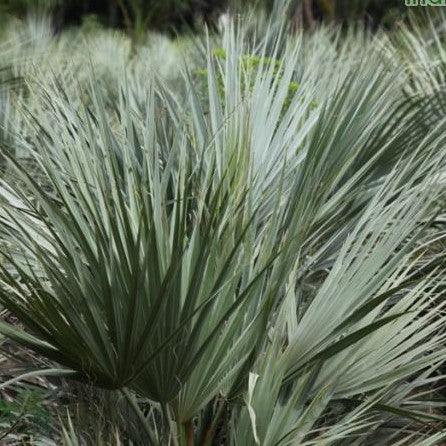-
Plant Description:
-
The Mazari Palm (Nannorrhops ritchiana) is a type of palm tree that is native to the arid regions of Pakistan and Afghanistan. It is a small to medium-sized tree that can grow up to 15 feet (4.5 meters) tall and has a trunk that is up to 1 foot (30 cm) in diameter. The leaves are feathery and green, and can grow up to 3 feet (1 meter) long. The trunk is covered in a thick layer of fibers, which are used for making rope, mats, and baskets.
The Mazari palm is well adapted to the harsh conditions of its native habitat and is drought-resistant. The tree can survive temperatures as low as -10 degrees Celsius, and can tolerate high winds and sandstorms. In the wild, it is commonly found in rocky, mountainous areas at elevations up to 4,500 feet (1,400 meters).
The tree is also used for ornamental purpose. It is drought resistant and is hardy to zone 8. These palm trees are seen in many city streets and gardens.
The tree is also propagated by seeds, it takes around 3-5 years to bear seed and it is propagated from seed and sowing is the best method.
Due to its hardiness, Mazari palm is also good for landscaping and gardening in arid regions. It has been introduced in many other areas as an ornamental tree.
-
Growing tips:
-
Mazari Palm trees are relatively low maintenance and can be easy to care for if you can provide them with the right growing conditions. Here are a few tips on how to care for a Mazari Palm tree:
-
Soil: Mazari Palm trees prefer well-draining sandy soils, but they can also grow in clay or loam soils as long as they are well-draining. It is also a salt-tolerant tree and can be grown in coastal regions.
-
Water: These palm trees are drought-resistant, and can survive on very little water, but they will benefit from regular watering during the growing season. Once established, they only need to be watered once a week or less, depending on the weather.
-
Light: Mazari Palm trees prefer full sun, but they can tolerate some shade. Make sure to place your palm tree in an area that gets at least 6 hours of direct sunlight a day.
-
Temperature: Mazari Palm trees can tolerate a wide range of temperatures, from -10 degrees Celsius to 40 degrees Celsius. They can survive in hot and dry climates but prefer a milder temperature of 20-30 degrees Celsius.
-
Fertilizer: These palm trees don't require a lot of fertilizer, but you can give them a balanced, slow-release fertilizer once a year in the spring to encourage growth.
-
Pruning: If you want to control the size of your Mazari Palm tree, you can trim the fronds with sharp scissors or pruning shears. It is best to remove the dead or yellow leaves as they appear.
-
Pests and Diseases: Mazari palm is relatively disease resistant but it can be attacked by some scale insects and thrips. Regularly checking for pests and treating them with pesticide may help.
By providing your Mazari Palm tree with the right growing conditions and proper care, it should thrive and bring a touch of the exotic to your landscape.
-
Benefits:
-
The Mazari Palm tree (Nannorrhops ritchiana) has a variety of benefits, both practical and aesthetic. Here are a few examples:
-
Ornamental: The Mazari Palm tree is a beautiful and exotic-looking tree that can add a unique and dramatic touch to any landscape. With its feathery leaves and thick, fibrous trunk, it is a striking addition to any garden or public space.
-
Adaptable: The Mazari Palm tree is well-adapted to arid regions and is tolerant of high temperatures, drought, and high winds, making it a good choice for landscaping in dry or desert areas.
-
Drought-tolerance: Mazari palm is drought-tolerant, it can survive on very little water, which makes it a good option for xeriscaping or for areas where water is scarce.
-
Material resource: The fibers from the trunk of the tree have been traditionally used for making rope, mats, and baskets. The fiber from trunk is also used to make paper.
-
Climate change resilient: due to its tolerance to harsh conditions and drought it is considered as a climate change resilient tree.
-
Wildlife habitat: This tree provide shelter to birds, small mammals and insects, and also its seeds are food for birds and animals.
-
Biodiversity: Mazari Palm tree can improve biodiversity in an area as it provides habitat for wildlife, and can also be used as a windbreak to protect other vegetation.
-
Soil conservation: These trees can help to stabilize the soil and reduce erosion by binding the soil with their roots and providing shade to the ground cover.
In addition to its practical and environmental benefits, Mazari Palm tree also has cultural and historical significance, as it has been used for centuries by the local people in Pakistan and Afghanistan for various purposes.




